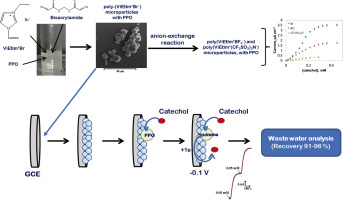当前位置:
X-MOL 学术
›
Microchem. J.
›
论文详情
Our official English website, www.x-mol.net, welcomes your feedback! (Note: you will need to create a separate account there.)
Electrochemical biosensor based on ionic liquid polymeric microparticles. An analytical platform for catechol
Microchemical Journal ( IF 4.8 ) Pub Date : 2018-05-01 , DOI: 10.1016/j.microc.2018.01.011 Marta Sánchez-Paniagua López , Beatriz López-Ruiz
Microchemical Journal ( IF 4.8 ) Pub Date : 2018-05-01 , DOI: 10.1016/j.microc.2018.01.011 Marta Sánchez-Paniagua López , Beatriz López-Ruiz

|
Abstract A catechol amperometric biosensor based on tyrosinase has been successfully developed. Tyrosinase was immobilized into microparticles prepared by polymerization of the ionic liquid 1-vinyl-3-ethyl-imidazolium bromide (ViEtIm+Br−). Different kinds of microparticles with entrapped tyrosinase based on ionic liquid were obtained from the latter, by a simple anion-exchange reaction. The synthesis of the microparticles was optimized. The analytical method based on the proposed device was also optimized in terms of pH and temperature. Optimal values were 6.5 and 25 °C, respectively. The characterization of both, microparticles and analytical device, was performed by cyclic voltammetry and electrochemical impedance spectroscopy. A linear relationship between the current signal and the catechol concentration was obtained in the range from 3.9·10−5 to 2.5·10−4 M, with a sensitivity of 17.95 mA M−1 cm−2 and a detection limit of 20 μM. The tyrosinase activity of lyophilized poly(ViEtIm+Br−) microparticles was unchanged for at least 9 months after their synthesis. The biosensor maintains 95% of the initial response 21 days after its first use. The biosensor has been applied for detecting phenol compounds in wastewater samples. The recoveries were found in the range of 91–96%.
中文翻译:

基于离子液体聚合物微粒的电化学生物传感器。儿茶酚的分析平台
摘要 成功研制了一种基于酪氨酸酶的儿茶酚电流生物传感器。酪氨酸酶被固定在通过离子液体 1-乙烯基-3-乙基-咪唑溴化物 (ViEtIm+Br-) 聚合制备的微粒中。通过简单的阴离子交换反应,从后者中获得了基于离子液体的不同种类的夹带酪氨酸酶的微粒。优化了微粒的合成。基于所提出设备的分析方法也在 pH 值和温度方面进行了优化。最佳值分别为 6.5 和 25 °C。通过循环伏安法和电化学阻抗谱进行微粒和分析装置的表征。电流信号与儿茶酚浓度之间的线性关系在 3 的范围内获得。9·10-5 至 2.5·10-4 M,灵敏度为 17.95 mA M-1 cm-2,检测限为 20 μM。冻干的聚(ViEtIm+Br-)微粒的酪氨酸酶活性在合成后至少 9 个月内没有变化。生物传感器在首次使用后 21 天保持初始响应的 95%。该生物传感器已应用于检测废水样品中的酚类化合物。发现回收率在 91-96% 的范围内。
更新日期:2018-05-01
中文翻译:

基于离子液体聚合物微粒的电化学生物传感器。儿茶酚的分析平台
摘要 成功研制了一种基于酪氨酸酶的儿茶酚电流生物传感器。酪氨酸酶被固定在通过离子液体 1-乙烯基-3-乙基-咪唑溴化物 (ViEtIm+Br-) 聚合制备的微粒中。通过简单的阴离子交换反应,从后者中获得了基于离子液体的不同种类的夹带酪氨酸酶的微粒。优化了微粒的合成。基于所提出设备的分析方法也在 pH 值和温度方面进行了优化。最佳值分别为 6.5 和 25 °C。通过循环伏安法和电化学阻抗谱进行微粒和分析装置的表征。电流信号与儿茶酚浓度之间的线性关系在 3 的范围内获得。9·10-5 至 2.5·10-4 M,灵敏度为 17.95 mA M-1 cm-2,检测限为 20 μM。冻干的聚(ViEtIm+Br-)微粒的酪氨酸酶活性在合成后至少 9 个月内没有变化。生物传感器在首次使用后 21 天保持初始响应的 95%。该生物传感器已应用于检测废水样品中的酚类化合物。发现回收率在 91-96% 的范围内。



























 京公网安备 11010802027423号
京公网安备 11010802027423号